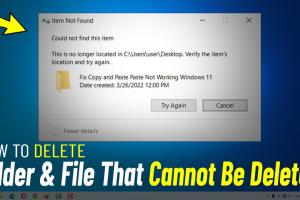Ultimate Guide to Deleting Unremovable Files: Step-by-Step Solutions

-
Quick Links:
- Introduction
- Understanding Unremovable Files
- Common Reasons Files Cannot Be Deleted
- Preliminary Steps Before Deletion
- Deletion Methods for Windows
- Deletion Methods for macOS
- Deletion Methods for Linux
- Advanced Tools and Software
- Case Studies
- Expert Insights
- Conclusion
- FAQs
Introduction
We've all been there — trying to delete a file only to be met with a stubborn error message. These unremovable files can disrupt our workflow and create frustration. Whether it's due to permissions, file locks, or corruption, knowing how to delete these files is crucial for maintaining a clean system. This guide will equip you with step-by-step solutions for Windows, macOS, and Linux systems to tackle these pesky files effectively.
Understanding Unremovable Files
Before diving into solutions, it's essential to understand what unremovable files are. These files may be locked by the operating system, in use by another application, or have restricted permissions. Additionally, system files and corrupted files often fall into this category, causing headaches for users trying to maintain their systems.
Common Reasons Files Cannot Be Deleted
- File is in use: The file is currently opened or used by a program.
- Permissions issue: You may not have the necessary permissions to delete the file.
- Corrupted files: Files that are damaged may resist deletion.
- System files: Certain files are protected by the operating system.
- File system errors: Problems within the file system can prevent deletions.
Preliminary Steps Before Deletion
Before attempting deletion, it's crucial to follow some preliminary steps:
- Check if the file is in use: Use Task Manager (Windows) or Activity Monitor (macOS) to see if the file is being used.
- Restart your computer: A simple reboot can often resolve file lock issues.
- Check permissions: Ensure you have the correct permissions to delete the file.
Deletion Methods for Windows
Method 1: Using Task Manager
1. Open Task Manager by pressing Ctrl + Shift + Esc.
2. Locate the program using the file in the "Processes" tab.
3. Right-click and select "End Task."
4. Attempt to delete the file again.
Method 2: Safe Mode
Booting into Safe Mode can help delete stubborn files:
1. Restart your computer.
2. Press F8 during startup to enter Advanced Boot Options.
3. Select "Safe Mode."
4. Navigate to the file and attempt deletion.
Method 3: Command Prompt
1. Open Command Prompt as an administrator.
2. Use the command del /f /q "C:\path\to\file" to force delete the file.
Deletion Methods for macOS
Method 1: Force Quit Applications
1. Open 'Force Quit Applications' from the Apple menu.
2. Select the application using the file and click "Force Quit."
3. Try deleting the file again.
Method 2: Terminal Command
1. Open Terminal.
2. Use the command sudo rm -rf /path/to/file to force delete the file.
Deletion Methods for Linux
Method 1: Terminal Command
1. Open Terminal.
2. Use the command sudo rm -rf /path/to/file to delete the file.
Method 2: Booting into Recovery Mode
1. Restart your computer and hold Shift to enter recovery mode.
2. Open the terminal in recovery mode and delete the file.
Advanced Tools and Software
Using third-party software can simplify the process of deleting unremovable files:
- Unlocker: A tool for unlocking locked files.
- FileAssassin: Designed to delete stubborn files and folders.
- CCleaner: Offers file deletion and system cleaning features.
Case Studies
Case Study 1: Deleting Corrupted Video Files
A user reported issues deleting corrupted video files that were holding up space on their hard drive. By using Command Prompt in Windows and booting into Safe Mode, they successfully removed the files.
Case Study 2: Locked PDF Files on macOS
Another user struggled with locked PDF files that wouldn’t delete. By using the Terminal command and Force Quit Applications, they could remove the files and regain access to storage.
Expert Insights
Experts suggest regularly maintaining your system to avoid encountering unremovable files. This includes running disk checks, updating software, and ensuring that files are not corrupted before attempting deletion.
Conclusion
Encountering files that cannot be deleted can be frustrating, but with the right tools and methods, you can overcome these challenges. Whether you're using Windows, macOS, or Linux, the solutions provided in this guide will help you maintain a clean and efficient system.
FAQs
1. Why can't I delete a file on my computer?
Files may be in use, have restricted permissions, or be corrupted.
2. How can I tell if a file is in use?
You can check your Task Manager (Windows) or Activity Monitor (macOS) to see which programs are running.
3. What should I do if a file is corrupted?
Try using command-line tools or specialized software to repair or delete the file.
4. Can I delete system files?
Generally, it's not advisable to delete system files as it may affect your operating system's functionality.
5. What is Safe Mode and how does it help?
Safe Mode starts your computer with a minimal set of drivers, which can help in deleting stubborn files.
6. Are there risks to using third-party software?
While many tools are safe, always ensure you're downloading from reputable sources.
7. What should I do if I accidentally delete a file?
Use data recovery software to attempt recovery of accidentally deleted files.
8. How can I prevent files from becoming unremovable?
Regular maintenance, such as checking for disk errors and updating software, can help.
9. Is it possible to delete files without administrative access?
In most cases, administrative access is required to delete protected or system files.
10. What is the best way to free up disk space?
Regularly clean temporary files, uninstall unused applications, and manage large files efficiently.
Random Reads